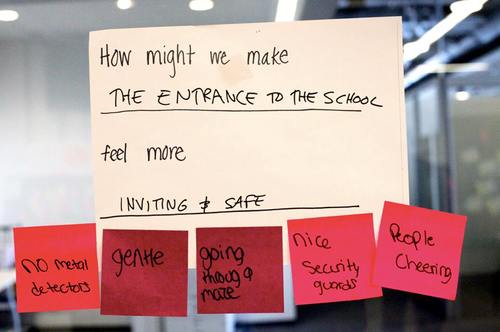How-Might-We Questioning
Description
How-Might-We Questioning is a format to reframe issues in opportunity statements. It sparks creativity, engages brainstorming and instigates innovation. Some of the most successful companies (like Google, and Facebook) in business today are known for tackling difficult creative challenges by first asking, How might we improve X … or find a new way to accomplish Y? – For Warren Berger, this is "the secret phrase top innovators use".
The idea of HMW is quite simple. As a product owner responsible for a product or service, you get suddenly some indications of annoyances, mistakes or concerns that happened during a certain time span with your product or service. For example, as a Dean of a college, you are caught by surprise that students feel uncomfortable in the hallways, especially in the entrance area. You initiate some research: maybe interviews, questionnaires, etc. with some students. Analysing these data gives you some insights: the problem could be caused by an uncosy and bearish, atmosphere, the architecture, the furniture, etc.
With these insights, you frame the negatively biased problem statements
"The entrance seems to be bearish and not cosy", "the furniture intimidates students", "the hallways are not safe"
into positive biased opportunities.
"How might we make an inviting and safe entrance?", "How might we create cosy furniture?", "How might we improve security and safeness in the hallways?"
The usage of the standardized, linguistic pattern
How might we <action> <what> for <whom> in order to <change something>
enables us a positive perspective of the product's resp. the service's deficiency. Inspired and brighten up, we share points of view, or provide inspiration, foster collaboration, and brainstorm solutions better.
Notice the following characteristics of well-crafted HMW questions.
- HMW statements are based on the insight we’ve gathered in the observation phase.
- HMWs are human-centred. – We always solve problems for people. Therefore have always the specific users and their needs in focus.
Do not focus on organisational constraints, technology, monetary returns or product specifications. - HMW questions are positive and inspirational. They do not intimidate someone or something. Good HMWs aim to inspire and energise. They reveal needs that should be met.
- An HMW suggests that a solution is possible and they offer you the chance to answer them in a variety of ways. A properly framed HMW doesn’t suggest a particular solution but gives you the perfect frame for innovative thinking.
- HMW statements should be broad enough for a wide range of solutions, but narrow enough that specific solutions can be created for them.
In design thinking, HMW questions open up to Ideation sessions where you explore ideas, which can help you solve your design challenge in an innovative way.
In product development and engineering, How-Might-We Questioning is a simple way to improve products or services. By running HMW workshops on a regular base, you can create easily a kaizen culture grounded on continuous improvement thinking. What about having an HMW 15 min at the end of each project or team meeting to collect fresh ideas?
Rules of How-Might-We Questioning
- Find the right problem for the HMW. Some proponents claim to use HMW for all kinds of problems. However, Tim Brown says the guideline, How-Might-We Questioning doesn’t work with all kinds of problems. The issues could be complicated but not complex (in the Cynefin sense).
- Find the right scope for the HMW. Broad enough for creative freedom, narrow enough to make it manageable.
- Start with an insight into the HMW. Observational data analysis is the prerequisite for HMW. You have to observe and to analyse your focus group. Design thinking calls the Emphatise Stage.
- Keep HMW human and system-centred.
- Craft it positive and inspirational.
When to use How-Might-We Questioning
- When to share a point of view.
- The issue should be broad enough for creative freedom. Do not use HMW with problems that are too broad (“How might we solve world hunger?”) or too narrow (“How might we increase profits by 5 % next quarter?”).
- Figuring out the right HMW questions to ask is a process, Tim Brown, Ideo, says: “You need to find the sweet spot.”
Further Readings
- Warren Berger: The Secret Phrase Top Innovators Use. Harvard Business Review. Sept. 12, 2017.
- Annabel: How Might We…?. Medium.org, Feb 20, 2017.
- DesinKit.org: How Might We.
- Rikke Dam, Teo Siang: Stage 2 in the Design Thinking Process: Define the Problem and Interpret the Results. Interaction Design Foundation.
: Ezekiel Harris, .







Leave A Comment